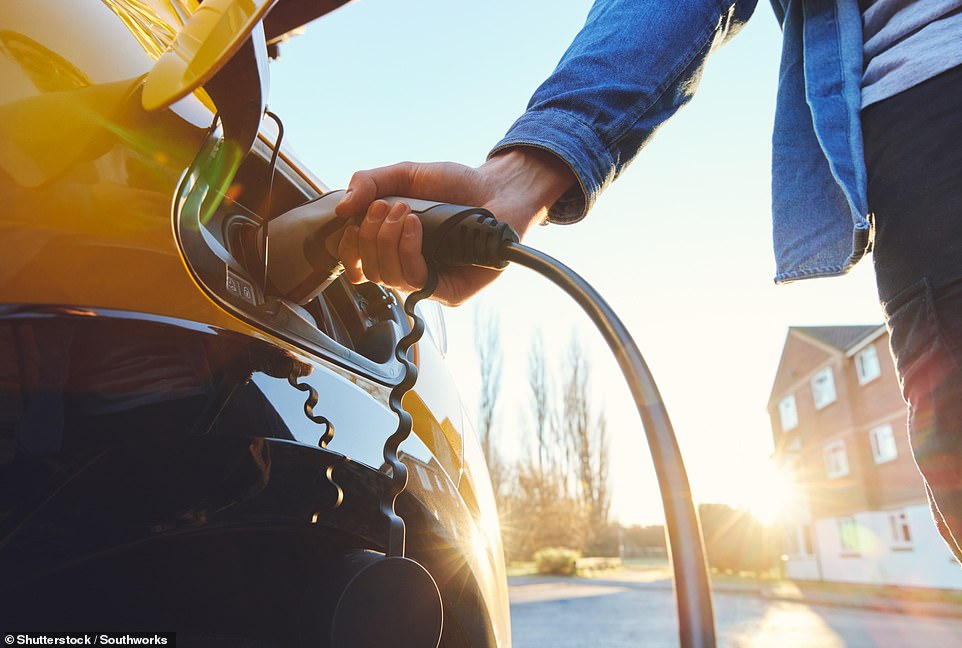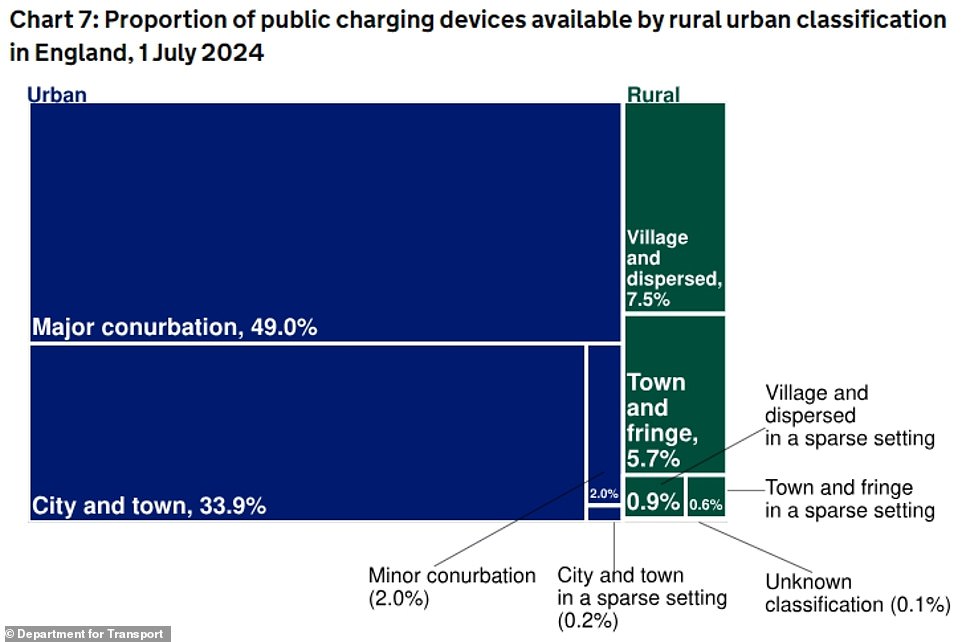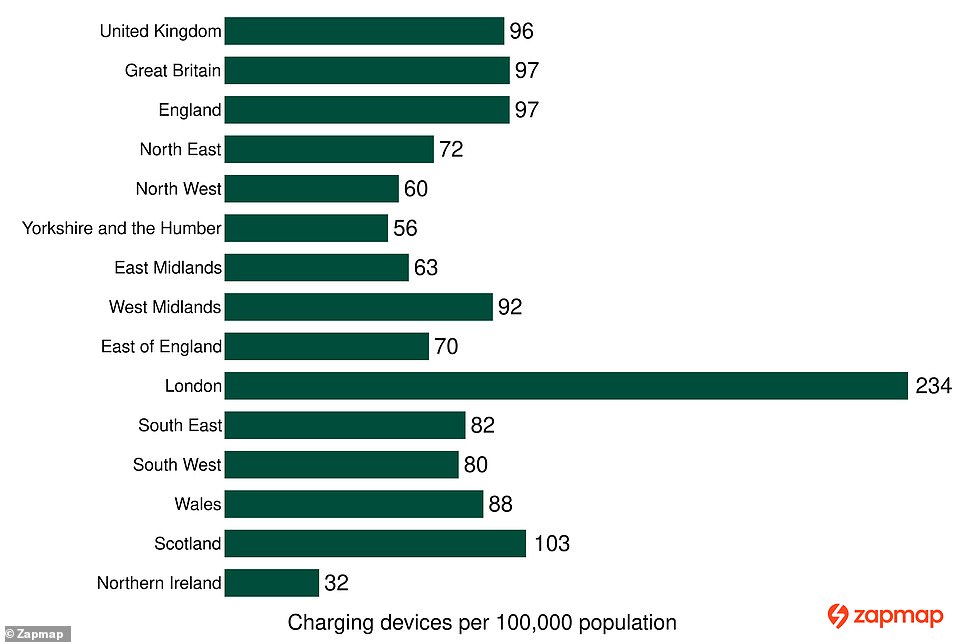Looking around for cheap ultra-fast EV charging could save a THIRD, but rural areas need better infrastructure
According to the latest analysis, the fixed costs for fast and fast charging have increased in recent months.
The cost of charging at fast chargers rose by 2 cents, while the cost of fast charging rose by 1 cent in August, AA’s EV Recharge Report shows.
The motoring organization is now calling for more fast chargers to be installed nationwide to prevent remote areas from falling behind in the national charging rollout
The AA’s August EV Recharge Report shows that the cost of charging at fast chargers has risen by two cents, while the cost of fast charging has risen by one cent.

Department for Transport statistics show only 14.9 percent of chargers are in rural areas, despite a 37 percent increase in devices between October 2023 and July 2024
While fast and fast charging costs rose slightly, peak charging rates at slow chargers fell by 1 cent in August.
This will help EV drivers who use slow charging to charge their cars as they do not have access to on-site parking and a home charger.
All other charging prices remained the same for the third month in a row.
The AA advises motorists to shop around to take advantage of the cheapest possible charging rates; shopping around for cheap ultra-fast charging during peak hours will yield an average savings of 24 percent, while off-peak savings are even greater at 34 percent.
Jack Cousens, AA’s head of road policy, said; ‘Even with a slight price increase, major savings are possible. By planning stops at ultra-fast chargers during off-peak hours, the driver can save a tenner compared to a fixed rate alternative.’
The organization is also calling on industry and government to improve the provision of public charges in rural areas.
| Charging type | Speed | Aug Avg (p/kWh) | July Avg (p/kWh) | Difference (p/kWh) | Cost to charge up to 80% | Pence per mile (p/mile) | ||||
|---|---|---|---|---|---|---|---|---|---|---|
| Domestic | Up to 7kW | 22 | 22 | 0 | £8.80 | 4.97 | ||||
| Slowly | Up to 8 kW | 51 | 51 | 0 | £20.40 | 11.53 | ||||
| Quick | 8-49 kW | 58 | 56 | 2 | £23.20 | 13.11 | ||||
| Quick | 50-149 kW | 74 | 73 | 1 | £29.60 | 16.72 | ||||
| Ultra-fast | +150kW | 77 | 77 | 0 | £30.80 | 17.4 | ||||
| PETROL | 142.10 pers | 145.10 pers | -2.8 pers | £45.54 | 12.65 | |||||
| Source – AA Recharge report, August 2024. * Calculations based on adding 80% to a Vauxhall e-Corsa, 50 kW, with a WLTP range of 350 km | ||||||||||
| Charging type | Speed | Aug Avg (p/kWh) | July Avg (p/kWh) | Difference (p/kWh) | Cost to charge up to 80% | Pence per mile (p/mile) | ||||
|---|---|---|---|---|---|---|---|---|---|---|
| Slow off peak hours | Up to 8 kW | 42 | 42 | 0 | £16.80 | 9.49 | ||||
| Slow peak | Up to 8 kW | 58 | 59 | – 1 | £23.20 | 13.11 | ||||
| Fast outside peak hours | 8-49 kW | 75 | 75 | 0 | £30.00 | 16.95 | ||||
| Fast peak | 8-49 kW | 79 | 79 | 0 | £31.60 | 17.85 | ||||
| Fast off-peak hours | 50-149 kW | 75 | 75 | 0 | £30.00 | 16.95 | ||||
| Fast peak | 50-149 kW | 79 | 79 | 0 | £31.60 | 17.85 | ||||
| Ultra-fast off-peak hours | +150kW | 51 | 51 | 0 | £20.40 | 11.53 | ||||
| Ultra-fast peak | +150kW | 59 | 59 | 0 | £23.60 | 13.33 | ||||
| PETROL | 142.30 pers | 145.10 pers | -2.80 pers | £45.54 | 12.65 | |||||
| Source – AA Recharge report, August 2024. * Calculations based on adding 80% to a Vauxhall e-Corsa, 50 kW, with a WLTP range of 350 km | ||||||||||

Jack Cousens, the AA’s head of roads policy, said: ‘Motorists leaving busy urban areas will have found that the country’s charging infrastructure needs more investment in rural areas. Outside of popular attractions, finding a charging point can be more challenging.
Recent statistics from the Department for Transport show that only 14.9 percent of chargers are in rural areas, despite a 37 percent increase in the number of devices between October 2023 and July 2024.
There were 8,255 devices in July, compared to 5,992 in October 2023.
Cousens said: ‘Drivers leaving busy, urban areas will have discovered that the country’s charging infrastructure needs more investment in rural areas. Outside of popular attractions, finding a charging point can be more challenging.
‘Meanwhile, the fictional village of Ambridge is in the process of opening its own EV charging point, complete with a café and possible hairdressers. If The Archers can build a charging station, others can make it a reality.”
How does each British country score on the rollout of tariffs?
Scotland is the best country in Britain for charger availability, with 103 devices per 100,000 inhabitants.
This puts it above the average supply in Britain, which is 96 per 100,000.
England comes in second with 97 per 100,000 residents, and Wales has a device-to-resident ratio of 88 per 100,000 residents.
However, Northern Ireland is far behind in installations, with just 32 chargers per 100,000 inhabitants.
This follows reports at the start of the year that Northern Ireland officials were ‘concerned’ about the lack of charging points leaving NI ‘behind the rest of Britain’.

The average number of charging points in Great Britain is 96 per 100,000, but Scotland leads the way when analyzed by country with 103 per 100,000. For cities and geographic areas, London is miles ahead at 23
There is also a North-South divide within England.
London has the highest availability of EV charging points in the whole of England.
Official data shows that there are 234 chargers per 100,000 inhabitants, which is ahead of the rest of the country in terms of infrastructure.
The southeast has an average of 82 devices per 100,000, while the southwest lags just behind with 80.
The West Midlands has a better ratio than both, with 92 chargers per 100,000.
By comparison, Yorkshire and the Humber has just 56 chargers per 100,000 residents. And the Northwest doesn’t fare much better with 60 chargers per 100,000.
However, the North East fares better overall at 72 per 100,000, but is still the only part of Britain where the number of devices has not increased in the last quarter.
Some links in this article may be affiliate links. If you click on it, we may earn a small commission. That helps us fund This Is Money and keep it free to use. We do not write articles to promote products. We do not allow a commercial relationship to compromise our editorial independence.
